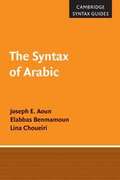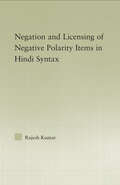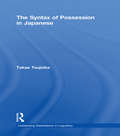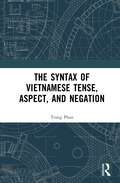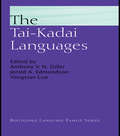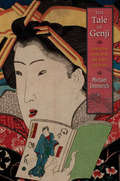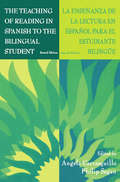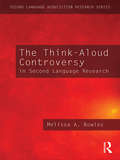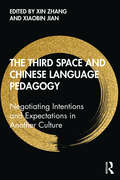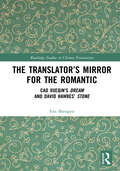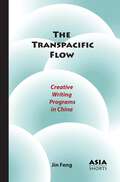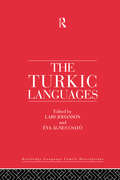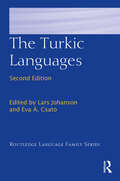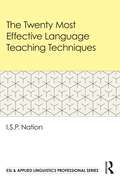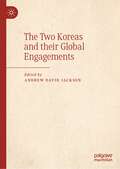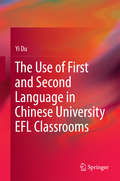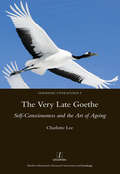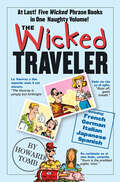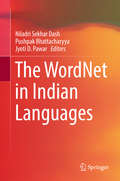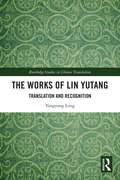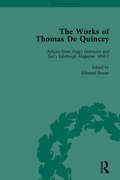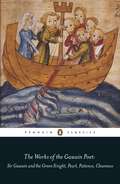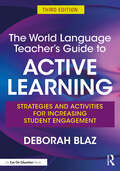- Table View
- List View
The Syntax of Arabic
by Joseph E. Aoun Elabbas Benmamoun Lina ChoueiriRecent research on the syntax of Arabic has produced valuable literature on the major syntactic phenomena found in the language. This guide to Arabic syntax provides an overview of the major syntactic constructions in Arabic that have featured in recent linguistic debates, and discusses the analyses provided for them in the literature. A broad variety of topics are covered, including argument structure, negation, tense, agreement phenomena, and resumption. The discussion of each topic sums up the key research results and provides new points of departure for further research. The book also contrasts Standard Arabic with other Arabic varieties spoken in the Arab world. An engaging guide to Arabic syntax, this book will be invaluable to graduate students interested in Arabic grammar, as well as syntactic theorists and typologists.
The Syntax of Negation and the Licensing of Negative Polarity Items in Hindi (Outstanding Dissertations in Linguistics)
by Rajesh KumarThis books studies syntax of NPIs and their interaction with sentential negatives in Hindi. It outlines the clause structure of Hindi and locates the syntactic position of sentential negatives as well as constituent negatives within the structure. It is argued that sentential negative in Hindi negation marker heads its own maximal projection, NegP, which is immediately dominated by TP. In addition to locating the position of negation markers in the clause structure, it outlines the distribution of negative polarity items (NPIs) in Hindi and the structural constraints on their licensing by sentential negative. The book argues that an NPI in Hindi is licensed overtly in the course of derivation by a c-commanding negative marker. The bulk of the evidence presented in this book argues against previous theoretical accounts that claim that NPI licensing involves covert syntactic operations such as LF movement or reconstruction. With respect to the classification of NPIs , this book also shows the existence of two different types of NPIs in Hindi; namely, strong NPIs and weak NPIs. Strong NPIs require a clause mate c-commanding negative licensor, whereas weak NPIs are quantifiers and are similar to free choice 'any' in English that are interpreted as NPIs in the presence of a c-commanding negative licensor.
The Syntax of Possession in Japanese (Outstanding Dissertations in Linguistics)
by Takae TsujiokaFirst Published in 2002. Routledge is an imprint of Taylor & Francis, an informa company.
The Syntax of Vietnamese Tense, Aspect, and Negation
by Trang PhanThe Syntax of Vietnamese Tense, Aspect, and Negation investigates familiar grammatical phenomena including Tense, Aspect, and Negation in a theoretically understudied language, Vietnamese. The purpose of this book is to thoroughly examine how these categories are realised and how they interact with one another in Vietnamese in the spirit of Generative Grammar, in particular, the Cartographic approach to syntax and its most recently developed lexicalisation technique, Nanosyntax. It is concluded that despite lacking inflectional tense, Vietnamese does have syntactic tense, i.e., Vietnamese has those structural positions which are dedicated to Tense and Aspect. In fact, Tense and Aspect in Vietnamese are realised via a rigid fine-grained functional sequence which syntacticises subtle semantic distinctions both preverbally and post-verbally. There is a two-way complicated relationship between Negation and Aspect in Vietnamese, which can be explained in a principled way by taking into consideration how the internal syntax of the temporal, aspectual, and negative markers derives their clausal syntax. This book also discusses how Vietnamese Tense, Aspect, and Negation pattern with, and differ from, their counterparts in Western Indo-European languages, and how this study contributes to a better understanding of East and mainland Southeast Asian languages more generally, as well as of language universally. This book will be of interest to both undergraduate and postgraduate students of contemporary linguistics, and for scholars interested in contemporary approaches to Vietnamese linguistics, and Southeast Asian languages more generally.
The Tai-Kadai Languages (Routledge Language Family Series)
by Anthony Diller Jerry Edmondson Yongxian LuoThe Routledge Language Family Series is aimed at undergraduates and postgraduates of linguistics and language, or those with an interest in historical linguistics, linguistics anthropology and language development. With close to 100 million speakers, Tai-Kadai constitutes one of the world's major language families. The Tai-Kadai Languages provides a unique, comprehensive, single-volume tome covering much needed grammatical descriptions in the area. It presents an important overview of Thai that includes extensive cross-referencing to other sections of the volume and sign-posting to sources in the bibliography. The volume also includes much new material on Lao and other Tai-Kadai languages, several of which are described here for the first time. Much-needed and highly useful, The Tai-Kadai Languages is a key work for professionals and students in linguistics, as well as anthropologists and area studies specialists. ANTHONY V. N. DILLER is Foundation Director of the National Thai Studies Centre, at the Australian National University. JEROLD A. EDMONDSON is Professor of Linguistics at the University of Texas Arlington and a member of the Academy of Distinguished Scholars. YONGXIAN LUO is Senior Lecturer in the Asia Institute at the University of Melbourne and a member of the Australian Linguistic Society.
The Tale of Genji: Translation, Canonization, and World Literature (Tuttle Classics)
by Michael EmmerichMichael Emmerich thoroughly revises the conventional narrative of the early modern and modern history of The Tale of Genji. Exploring iterations of the work from the 1830s to the 1950s, he demonstrates how translations and the global circulation of discourse they inspired turned The Tale of Genji into a widely read classic, reframing our understanding of its significance and influence and of the processes that have canonized the text.Emmerich begins with an analysis of the lavishly produced best seller Nise Murasaki inaka Genji (A Fraudulent Murasaki's Bumpkin Genji, 1829–1842), an adaptation of Genji written and designed by Ryutei Tanehiko, with pictures by the great print artist Utagawa Kunisada. He argues that this work introduced Genji to a popular Japanese audience and created a new mode of reading. He then considers movable-type editions of Inaka Genji from 1888 to 1928, connecting trends in print technology and publishing to larger developments in national literature and showing how the one-time best seller became obsolete. The study subsequently traces Genji's reemergence as a classic on a global scale, following its acceptance into the canon of world literature before the text gained popularity in Japan. It concludes with Genji's becoming a "national classic" during World War II and reviews an important postwar challenge to reading the work after it attained this status. Through his sustained critique, Emmerich upends scholarship on Japan's preeminent classic while remaking theories of world literature, continuity, and community.
The Teaching of Reading in Spanish to the Bilingual Student: La Ense¤anza De La Lectura En Espa¤ol Para El Estudiante Biling e
by Angela Carrasquillo Philip SeganThis dual-language text provides theory and methodology for teaching reading in Spanish to Spanish/English bilingual or Spanish-dominant students. The goal is to help educators teach these students the skills necessary to become proficient readers and, thus, successful in the school system. At the very core of the book are the hispano-parlantes--the Spanish-speaking children--who bring to the schools, along with their native language and cultures, a wealth of resources that must be tapped and to whom all educators have a responsibility to respond. True to the concepts of developing bilingual educators to serve bilingual students, the text presents chapters in English and Spanish. Each chapter is written in only one language at the preference of the author. Thus, to be successful with this book, the reader must be bilingual. Themes emphasized in the text include current reading methodologies, the concept of reading as developmental literacy skills, reading in the content areas, new views of the development of proficiency in the second language, issues related to students with special learning needs, assessment, and the uses of technology in the delivery of instruction. Never losing sight of its goal--to teach reading in Spanish to bilingual or Spanish-dominant students--the book includes a series of focusing questions and follow-up activities; these are not simply translations of existing activities, strategies, and techniques intended for monolingual English students, but specifically designed to be appropriate for Spanish-speaking students. Directed to university preservice and in-service instructors of reading and bilingual education as well as administrators and district- and school-level staff developers who work with Hispanic populations, the book is sensitive at all times to nuances of the languages and cultures of the intended audiences.
The Think-Aloud Controversy in Second Language Research (Second Language Acquisition Research Series)
by Melissa A. BowlesThe Think-Aloud Controversy in Second Language Research aims to answer key questions about the validity and uses of think-alouds, verbal reports completed by research participants while they perform a task. It offers an overview of how think-alouds have been used in language research and presents a quantitative meta-analysis of findings from studies involving verbal tasks and think-alouds. The book begins by presenting the theoretical background and empirical research that has examined the reactivity of think-alouds, then offers guidance regarding the practical issues of data collection and analysis, and concludes with implications for the use of think-alouds in language research. With its focus on a much-discussed and somewhat controversial data elicitation method in language research, this timely work is relevant to students and researchers from all theoretical perspectives who collect first or second language data. It serves as a valuable guide for any language researcher who is considering using think-alouds.
The Third Space and Chinese Language Pedagogy: Negotiating Intentions and Expectations in Another Culture
by Xin Zhang; Xiaobin JianThe Third Space and Chinese Language Pedagogy presents the Third Space as a new frame through which foreign language pedagogy is conceptualized as a pedagogy of negotiating intentions and expectations in another culture. The field of Chinese as a foreign language (CFL) in the past decades has been expanding rapidly at the beginning and intermediate levels, yet it is lacking in scholarship on the true advanced level both in theory building and research-supported curriculum and material development. This book argues that it is time for CFL to go beyond merely satisfying the desire of gazing at the other, whether it is curiosity about the other or superiority over the other, to focusing on learning to work with the other. It reimagines the field as co-constructing a transcultural Third Space where learners are becoming experts in negotiating intentions and expectations in another culture. It presents a range of research-based CFL pedagogical scholarship and practices especially relevant to the advanced level and to the goal of enabling learners to go past fans or critics to become actors/players in the game of cross-lingual and intercultural cooperation.
The Translator’s Mirror for the Romantic: Cao Xueqin's Dream and David Hawkes' Stone (Routledge Studies in Chinese Translation)
by Fan ShengyuThe Translator’s Mirror for the Romantic: Cao Xueqin’s Dream and David Hawkes’ Stone is a book that uses precious primary sources to decipher a master translator’s art in Stone, a brilliant English translation of the most famous Chinese classic novel Dream. This book demonstrates a bilingual close reading which sheds light on both the original and its translation. By dividing the process of translation into reading, writing, and revising, and involving the various aspects of Sinological research, textual criticism, recreation, and literary allusions, this book ventures to emphasise the idea of translation as a dialogue between the original and the translated text, between the translator and his former self, and a learning process both for the translator and the reader of his translation. Any student of Chinese language and literature, or Chinese–English translation, will benefit from this book; for students and scholars who want to study David Hawkes and his Stone, this book is an indispensable aid. Readers will be interested to see how a non-theoretical analysis could be used to evaluate this translation, for it makes an extremely important and useful contribution to this subject.
The Transpacific Flow: Creative Writing Programs in China (Asia Shorts)
by Jin FengWhat happens when a US cultural institution is imported to China, the purported chief rival of the United States in the twenty-first century? The first book-length account of university-based creative writing programs in China, this book reveals how Chinese intellectuals adapt American-style writing programs such as the Iowa Writers’ Workshop and the International Writing Program at Chinese universities to seek agency and literary innovation in the last two decades. The rise of creative writing programs in China explains broader issues of cultural production in an increasingly authoritarian and market-oriented postsocialist state. By telling a unique story of Chinese intellectuals’ interactions with an influential Western cultural institution, this book also shows how varied cultural and geopolitical priorities can rewrite the story of the global influence of the United States.
The Turkic Languages (Routledge Language Family Series)
by Lars Johanson Éva Ágnes JohansonThe Turkic Languages examines the modern languages within this wide-ranging language family and gives an historical overview of their development.The first part covers generalities, providing an introduction to the grammatical traditions, subgrouping and writing systems of this language family.The latter part of the book focuses on descriptions of the individual languages themselves. Each language description gives an overview of the language followed by detail on phonology, morphology, syntax, lexis and dialects. The language chapters are similarly structured to enable the reader to access and compare information easily.Each chapter represents a self-contained article written by a recognised expert in the field. Suggestions are made for the most useful sources of further reading and the work is comprehensively indexed.
The Turkic Languages (Routledge Language Family Series)
by Lars Johanson Éva Á. CsatóThe Turkic languages are spoken today in a vast geographical area stretching from southern Iran to the Arctic Ocean and from the Balkans to the great wall of China. There are currently 20 literary languages in the group, the most important among them being Turkish with over 70 million speakers; other major languages covered include Azeri, Bashkir, Chuvash, Gagauz, Karakalpak, Kazakh, Kirghiz, Noghay, Tatar, Turkmen, Uyghur, Uzbek, Yakut, Yellow Uyghur and languages of Iran and South Siberia. The Turkic Languages is a reference book which brings together detailed discussions of the historical development and specialized linguistic structures and features of the languages in the Turkic family. Seen from a linguistic typology point of view, Turkic languages are particularly interesting because of their astonishing morphosyntactic regularity, their vast geographical distribution, and their great stability over time. This volume builds upon a work which has already become a defining classic of Turkic language study. The present, thoroughly revised edition updates and augments those authoritative accounts and reflects recent and ongoing developments in the languages themselves, as well as our further enhanced understanding of the relations and patterns of influence between them. The result is the fruit of decades-long experience in the teaching of the Turkic languages, their philology and literature, and also of a wealth of new insights into the linguistic phenomena and cultural interactions defining their development and use, both historically and in the present day. Each chapter combines modern linguistic analysis with traditional historical linguistics; a uniform structure allows for easy typological comparison between the individual languages. Written by an international team of experts, The Turkic Languages will be invaluable to students and researchers within linguistics, Turcology, and Near Eastern and Oriental Studies.
The Twenty Most Effective Language Teaching Techniques (ISSN)
by I.S.P. NationFrom leading scholar and applied linguist Paul Nation, this book describes and explains the 20 most effective and efficient language teaching techniques and why they work. Backed by decades of research and expertise, Nation examines the principles of learning connected to these techniques, as well as the factors affecting their choice and usage.These techniques are organized around the four skills of listening, speaking, reading, and writing. For each skill, there is an opportunity for learning through meaning-focused use, an opportunity for learning through deliberate study, and a window for fluency development through working with easy material. Each technique is described and analyzed to demonstrate its learning goals and the principles of learning in use.In demonstrating key techniques and methods for language learning, this book is particularly useful for pre-service teachers and students in applied linguistics, TESOL, and language teaching. Each chapter also has a substantial list of research topics for projects or theses.
The Two Koreas and their Global Engagements
by Andrew David JacksonThis book departs from existing studies by focusing on the impact of international influences on the society, culture, and language of both North and South Korea. Since President Kim Young Sam’s segyehwa drive of the mid-1990s, South Korea has become a model for successful globalization. In contrast, North Korea is commonly considered one of the least internationally integrated countries. This characterization fails to account for the reality of the two Koreas and their global engagements. The opening essay situates the chapters by highlighting some significant contrasts and commonalities between the experiences of North and South Korea’s history of engagement with the world beyond the Peninsula. The chapters explore both the longer-term historical influence of Korea’s international contacts as well as specific Korean cultural, linguistic, and social developments that have occurred since the 1990s demise of the global Cold War and greater international integration.
The Upanishads Volume 2
by Joseph Campbell Swami NikhilanandaSwami Nikhilananda's English translation of three of the major Upanishads - Svetasvatara, Prasna, and Mandukya - offers a scholarly, yet readable version of the sacred texts of ancient India. The Upanishads form the foundation of the Hindu religion and describe the ultimate objective of life - the liberation of the soul from the bondage of the phenomenal world. Swami Nikhilananda's clear and insightful writing combined with notes and explanation based on the commentary of Sankaracharya, the great eighth-century philosopher and mystic of India, will help the spiritual seeker delve into the meaning of these spiritual treasures. This second of four volumes also contains an introduction with a general outline of Hindu ethics.
The Use of First and Second Language in Chinese University EFL Classrooms
by Yi DuThis book investigates first language (L1) and second language (L2) use in Chinese university classrooms, focusing on the experiences of four Chinese EFL teachers who were teaching non-English major students at four different proficiency levels. It examines these four teachers' actual use of L1 and L2, including the distribution of their L1 and L2 use; the circumstances, functions and grammatical patterns of their language use; and their language use across different frames of classroom discourse. It also explores their attitudes and beliefs regarding this issue in depth, as well as their own perceptions of and reasons for their language use and possible influencing factors. Through its detailed analysis of the teachers' language use, as well as their respective beliefs and decision-making techniques, this book contributes to L2 teachers' professional development and L2 teaching in general, especially with regard to establishing a pedagogically principled approach to L1 and L2 use.
The Valentine Generation and Other Stories (Structural Readers)
by John UpdikeAn anthology of short stories from John Updike, John Wain, Doris Lessing, Frank Tuohy, H. E. Bates, and Elizabeth Taylor. After the stories are exercises in comprehension and structure.
The Very Late Goethe: Self-Consciousness and the Art of Ageing
by Charlotte LeeGoethe's career was an unusually long and productive one: he became a literary celebrity in the 1770s and remained so until his death in 1832. The distinguishing feature of his last works is their self-consciousness, their preoccupation both with the business of writing and with personal development. In the first cross-genre study of this period of Goethe's work, Charlotte Lee traces the theme in his last major poems and autobiographical writings, before turning to the two 'giants', 'Wilhelm Meisters Wanderjahre' and 'Faust II'. All these works share a tendency to allude subtly to earlier moments from Goethe's own literary output, but to fashion them into writing which is quite new - even though (or perhaps because) he himself is old. This book seeks to understand the unique perspective of one nearing the end of a long life.
The Wicked Traveler: 8-copy Counter Display (Wicked Travel Ser.)
by Howard Tomb<P>Respond to Japanese Noh theater like a native: Kazoku sorrote no seppuku ga yokatta. (“I love the part where the whole family disembowels themselves.”) <P>Speak to homicidal Parisian taxi drivers in a language they’ll understand: Ou avez-vous appris à conduire? <P>En Italie? (“Where did you learn to drive? Italy?”) <P>Discuss Italian olive oil with the proper degree of reverence: Un assaggio ti dice che le olive sono maturate di fronte ad una cattedrale. (“One taste tells you the olives grew in full view of the cathedral.”) <P>Establish privacy needs in Mexico: Preferiría una habitación sin alacranes. (“I’d prefer a room without scorpions.”) <P>With seven titles and over 1.2 million copies in print, Howard Tomb’s Wicked phrase book series is the fiendishly irreverent—and very successful—collection that gives travelers the words they wish they could utter while, say, attempting to find the exit of the Louvre or facing a plate of fugu (poisonous blowfish) in Japan. Now, the five most popular Wicked books—Italian, French, Japanese, German, and Spanish— have been updated and compiled into The Wicked Traveler. <P>Because, as Howard Tomb writes in his new introduction: “Every country is different, but all foreign places have one thing in common: they’re weird.”
The WordNet in Indian Languages
by Niladri Sekhar Dash Pushpak Bhattacharyya Jyoti D. PawarThis contributed volume discusses in detail the process of construction of a WordNet of 18 Indian languages, called "Indradhanush" (rainbow) in Hindi. It delves into the major challenges involved in developing a WordNet in a multilingual country like India, where the information spread across the languages needs utmost care in processing, synchronization and representation. The project has emerged from the need of millions of people to have access to relevant content in their native languages, and it provides a common interface for information sharing and reuse across the Indian languages. The chapters discuss important methods and strategies of language computation, language data processing, lexical selection and management, and language-specific synset collection and representation, which are of utmost value for the development of a WordNet in any language. The volume overall gives a clear picture of how WordNet is developed in Indian languages and how this can be utilized in similar projects for other languages. It includes illustrations, tables, flowcharts, and diagrams for easy comprehension. This volume is of interest to researchers working in the areas of language processing, machine translation, word sense disambiguation, culture studies, language corpus generation, language teaching, dictionary compilation, lexicographic queries, cross-lingual knowledge sharing, e-governance, and many other areas of linguistics and language technology.
The Works of Lin Yutang: Translation and Recognition (Routledge Studies in Chinese Translation)
by Yangyang LongThe Works of Lin Yutang is the first book to provide a comprehensive study of Lin Yutang’s translation theory and translated (and written) works in English as a whole, examined from the perspective of his pursuit of recognition of cultural equity between China and the English-speaking world. The arc of the book is Lin’s new method of translating China to the Anglophone world, which is crucial to rendering Chinese culture as an equal member of the modern world. This book identifies Lin’s legacy of translation and recognition as his acknowledgement of source and target cultural territories in translation, and at the same time, his questioning of perspectives that privilege the authority of either. This book will appeal to scholars and students in Translation Studies, World and Comparative Literature, Literary and Cultural Studies, and Chinese Studies. It can also be used as a reference work for practitioners in translation and creative writing.
The Works of Thomas De Quincey, Part III vol 17
by Barry Symonds Grevel LindopThomas De Quincey (1785-1859) is considered one of the most important English prose writers of the early-19th century. This is the final part of a 21-volume set presenting De Quincey's work, also including previously unpublished material.
The Works of the Gawain Poet: Sir Gawain and the Green Knight, Pearl, Cleanness, Patience
by Ad Putter Myra StokesA new volume of the works of the Gawain poet, destined to become the definitive edition for students and scholars.This volume brings together four works of the unknown fourteenth-century poet famous for the Arthurian romance Sir Gawain and the Green Knight, in their original Middle English. In one of the great tales of medieval literature, Gawain, the noblest knight of King Arthur's court, must keep a deadly bargain with a monstrous knight and resist the advances of his host's beautiful wife. The dream vision of Pearl depicts a bereaved father whose lost child leads him to glimpse heaven. And in moral poems based on stories from the Bible, Cleanness warns against sins of the flesh and of desecration, while Patience encourages readers to endure suffering as God's will.Little is known about the so-called 'Gawain poet', who wrote during the late fourteenth century. It is believed that he came from south-east Cheshire, an important cultural and economic centre at the time, and he was clearly well-read in Latin, French and English. Although he is not named as the author of Sir Gawain and the Green Knight, Pearl, Patience, Cleanness, the four works have been attributed to him based on a careful comparison of their language, date and themes.Myra Stokes was formerly Senior Lecturer in the Department of English at Bristol University. Her books include Justice and Mercy in Piers Plowman and The Language of Jane Austen.Ad Putter teaches at the English Department and the Centre for Medieval Studies of the University of Bristol, where is Professor of Medieval English Literature. His monographs include Sir Gawain and the Green Knight and French Arthurian Romance and An Introduction to the Gawain Poet, and he is also co-editor of The Cambridge Companion to the Arthurian Legend.
The World Language Teacher's Guide to Active Learning: Strategies and Activities for Increasing Student Engagement
by Deborah BlazEnhance your students’ success and improve the likelihood of retention with the easy-to-implement activities and strategies in this book! Bestselling author Deborah Blaz shows how to create a classroom in which students can actively experience and explore a world language. The new edition features updates in every chapter and incorporates the latest ACTFL standards, more information on teaching with authentic resources, a new chapter on teaching with technology, and additional resources for personalized learning. It is organized to allow you to easily find and pull activities you want to use in your classroom the very next day. You’ll learn how to… mix up your repertoire of activities, games, and exercises to keep students engaged; introduce students to the culture of the language you teach by hosting parties and celebrations; overcome some of the biggest obstacles in the path to fluency, including verb conjugation, using object pronouns, and the subjunctive mood; customize your teaching strategies to accommodate a broader range of talents, skills, and intelligences; implement new assessment strategies to improve verbal skills and reading comprehension; and more! Bonus: Downloadable versions of some of the resources in this book are available on the Routledge website at www.routledge.com/9781032258294 so you can print and distribute them for immediate classroom use.
